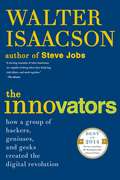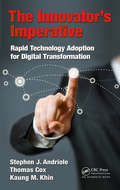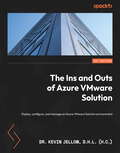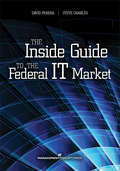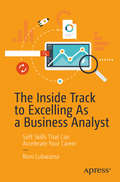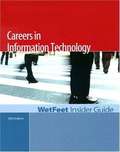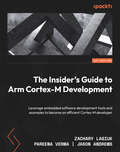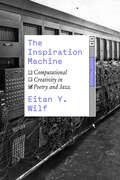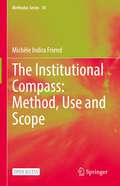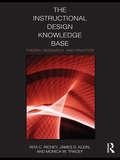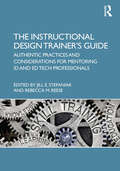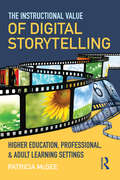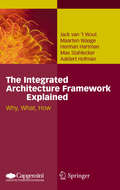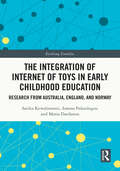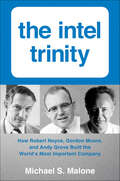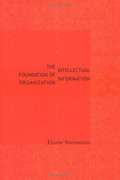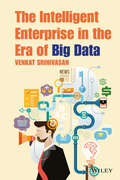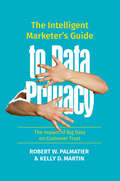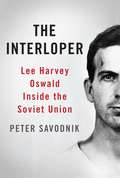- Table View
- List View
The Innovators: How a Group of Hackers, Geniuses, and Geeks Created the Digital Revolution
by Walter IsaacsonFollowing his blockbuster biography of Steve Jobs, Walter Isaacson&’s New York Times bestselling and critically acclaimed The Innovators is a &“riveting, propulsive, and at times deeply moving&” (The Atlantic) story of the people who created the computer and the internet.What were the talents that allowed certain inventors and entrepreneurs to turn their visionary ideas into disruptive realities? What led to their creative leaps? Why did some succeed and others fail? The Innovators is a masterly saga of collaborative genius destined to be the standard history of the digital revolution—and an indispensable guide to how innovation really happens. Isaacson begins the adventure with Ada Lovelace, Lord Byron’s daughter, who pioneered computer programming in the 1840s. He explores the fascinating personalities that created our current digital revolution, such as Vannevar Bush, Alan Turing, John von Neumann, J.C.R. Licklider, Doug Engelbart, Robert Noyce, Bill Gates, Steve Wozniak, Steve Jobs, Tim Berners-Lee, and Larry Page. This is the story of how their minds worked and what made them so inventive. It’s also a narrative of how their ability to collaborate and master the art of teamwork made them even more creative. For an era that seeks to foster innovation, creativity, and teamwork, The Innovators is “a sweeping and surprisingly tenderhearted history of the digital age” (The New York Times).
The Innovator’s Imperative: Rapid Technology Adoption for Digital Transformation
by Stephen J Andriole Thomas Cox Kaung M. KhinThe pace of technological change is accelerating, hyper competition is growing, opportunities for business model disruption are exploding, and comprehensive cloud delivery is readily available. These factors challenge every aspect of business technology strategy. The Innovator’s Imperative: Rapid Technology Adoption for Digital Transformation prepares twenty-first century businesses leaders for competing and leading in this disruptive digital environment. Five years of research conducted by the authors suggests that leading companies have all but abandoned the requirements analysis and modeling best practices of the twentieth century. Accordingly, the authors put forth the innovator’s imperative that contends: All companies wanting to be competitive should adopt emerging and disruptive technologies as quickly as possible, and in many cases, immediately. Technology is driving business strategy, and companies are rethinking their technology strategy, especially the governance that determines how and why technology investments are made. Based on their research the authors have developed a five-step framework for digital transformation: Model and simulate Identify high-leverage opportunities Prioritize transformational targets Identify digital opportunities Find courageous leaders The book explains each of these steps to guide business leaders in architecting digital transformation projects according to their organization’s market positions, budgets, objectives, and corporate culture. Hyper-competitive, disruptive companies are jumping across technology adoption phases without regard to any phasing whatsoever. Companies focused on digital transformation often adopt emerging technologies immediately. They have become early adopters of technologies that can impact existing—and create whole new—business models and processes. This book examines this jump into new technologies, processes, and business models to prepare twenty-first century business leaders to make that leap.
The Ins and Outs of Azure VMware Solution: Deploy, configure, and manage an Azure VMware Solution environment
by D.H.L. (h.c.) JellowManage VMware workloads in Azure VMware Solution and enable hybrid connectivity between on-premises datacenters and Azure with this extensive guide focusing on best practices and use casesKey FeaturesExtend or migrate your existing VMware environment to Azure VMware Solution smoothlyDiscover best practices that are based on real customer experiencesJoin the cloud revolution by conducting the most suitable migration for your workloadsBook DescriptionOrganizations over the world are migrating partially or fully to the cloud, but with the whole slew of providers, tools, and platforms available, knowing where to start can be quite challenging. If you know Microsoft Azure VMware Solution, you know it is the quickest way to migrate to the cloud without needing application modernization or rework. You can retain the same VMware tools to manage your environment while moving to Azure. But how does it work? The Ins and Outs of Azure VMware Solution has the answer.This high-level, comprehensive yet concise guide to Azure VMware Solution starts by taking you through the architecture and its applicable use cases. It will help you hit the ground running by getting straight to the important steps: planning, deploying, configuring, and managing your Azure VMware Solution instance. You'll be able to extend your existing knowledge of Azure and VMware by covering advanced topics such as SRM and governance, setting up a hybrid connection to your on-premises datacenter, and scaling up using disk pools.By the end of the VMware book, you'll have gone over everything you need to transition to the cloud with ease using Azure VMware Solution.What you will learnGet to grips with the overall architecture of Azure VMware SolutionDiscover Enterprise-scale for Azure VMware SolutionDeploy an Azure VMware private cloud successfullyDeploy and configure HCX in Azure VMware SolutionConfigure NSX-T network segments with the NSX-T ManagerConfigure internet access, traffic inspection, and storage for AVSIntegrate Azure VMware Solution with Azure-native servicesUse governance to improve your cloud portfolioWho this book is forThis book is for VMware administrators, cloud solutions architects, and anyone interested in learning how to deploy and configure an AVS environment in Azure. Technology leaders who want to get out of the datacenter business or expand their on-premises datacenter into Microsoft Azure will also find this book useful. Familiarity with VMware solutions and a basic understanding of Azure networking is necessary to get started with this book.
The Inside Guide to the Federal IT Market
by David Perera Steve CharlesUnlock the Door to the Federal IT MarketplaceHere's your key to selling IT goods and services to the government. David Perera and Steve Charles present the ins and outs of successfully competing for—and winning—a share of the tens of billions of dollars the federal government spends each year on IT. Getting a piece of that business is not easy—it takes accurate knowledge of systems and procedures, as well as sharp insight into the structure and details of government procurement.The Inside Guide to the Federal IT Market penetrates the haze of jargon and apparent complexity to reveal the inner workings of the IT contracting process. Whether you're just setting out or seek a bigger share, this comprehensive book provides valuable information you can put to immediate use. The Inside Guide to the Federal IT Market covers:• Technology standards• Basic contracting concepts• Advanced contracting concepts, such as getting on and staying on the GSA schedules• The effect of the federal budget process on the sales cycle• What you need to know about ethics to earn business fairly, without avoidable delays and hassleThis book's focus on the IT market makes it a unique reference on federal procurement for private companies. Government procurement personnel will also find the depth and breadth of coverage useful in reviewing and evaluating IT offerings.
The Inside Track to Excelling As a Business Analyst: Soft Skills That Can Accelerate Your Career
by Roni LubwamaThe role of the business analyst sits at the intersection of business operations, technology, and change management. The job requires a plethora of both soft skills and technical skills, as it must translate the needs of business users into action items for functional applications. On top of this, in-demand technologies have caused tectonic shifts in the way companies operate today, and business analysts must be prepared to adapt.The Inside Track to Excelling as a Business Analyst teaches you how to effectively harness skills, techniques, and hacks to grow your career. Author Roni Lubwama expertly walks you through case studies that illustrate how to diffuse the challenges and bottlenecks that business analysts commonly encounter. He provides you with digestible answers to the complexities faced when delivering digital transformation projects to end users. This book is not a self-help guide rife with corporate buzzwords, but a practical handbook with immediate applications from a true insider. Equip yourself with vital soft skills, ask the right questions, manage your stakeholders, and bring your projects to a successful close with The Inside Track to Excelling as a Business Analyst. Whether you are new to the role and want a leg up, or a veteran business operator looking to infuse new strategies into your work, this book instills lessons that will assist you throughout your entire career. In this time of rapid change in the digital space, business analysts are asked for more adaptability than ever before, and The Inside Track to Excelling as a Business Analyst is your ideal starting point.What You Will LearnDeploy a non-technical skills toolkit to resolve a wide array of bottlenecks particular to the business analyst practice.Defuse the many intractable and common scenarios you will encounter as a business analyst by the application of soft skills.Understand the difference between the theory and the actual practice of the business analyst role. Who This Book Is For Newbie and experienced business analysts who are looking to understand and contextualize their role; managers; other tech professionals looking to understand the business analyst role; and curious lay readers.
The Insider Guide to Careers in Information Technology (2005 Edition)
by WetFeetDespite the technology sector downturn and the outsourcing trend, IT professions are among the fastest-growing and highest-paying jobs in the economy. This WetFeet Insider Guide explores current industry trends, where IT professionals commonly find work, major IT job functions, and what industry professionals like and dislike about the work.
The Insider Threat: Assessment and Mitigation of Risks
by Eleanor E. ThompsonThis book provides emergent knowledge relating to physical, cyber, and human risk mitigation in a practical and readable approach for the corporate environment. It presents and discusses practical applications of risk management techniques along with useable practical policy change options. This practical organizational security management approach examines multiple aspects of security to protect against physical, cyber, and human risk. A practical more tactical focus includes managing vulnerabilities and applying countermeasures. The book guides readers to a greater depth of understanding and action-oriented options.
The Insider Threat: Combatting the Enemy Within
by Clive BlackwellData Loss Prevention is easier and cheaper than cure - the insider threat poses a significant and increasing problem for organisations. The use of highly connected computers makes controlling information much more difficult than in the past. This new pocket guide intends to shed light on the key security issues facing organisations from insiders to get them up to speed quickly. It is written by Clive Blackwell who is a researcher at Royal Holloway, University of London, where his main field is security architecture. He has developed a practical three-layer security architecture to model computer networks such as the Internet and other complex systems such as critical infrastructure. He is currently applying the model to the insider threat within different business sectors, which has resulted in several academic papers. Clive is a regular speaker on security at both academic and business conferences in the US and Europe as well as the UK. He has recently been invited to give talks on the insider threat at two major business conferences. He has about 20 publications to his name within the last two years, so he is aware of the security issues facing business.
The Insider's Guide to Arm Cortex-M Development: Leverage embedded software development tools and examples to become an efficient Cortex-M developer
by Zachary Lasiuk Pareena Verma Jason AndrewsLearn and implement the latest Arm Cortex-M microcontroller development concepts such as performance optimization, security, software reuse, machine learning, continuous integration, and cloud-based development from industry expertsKey FeaturesLearn how to select the best Cortex-M hardware, software, and tools for your projectUnderstand the use of key software components and how to optimize and develop modern applicationsGet hands-on experience implementing quality software using example code provided in the bookPurchase of the print or Kindle book includes a free eBook in the PDF formatBook DescriptionCortex-M has been around since 2004, so why a new book now? With new microcontrollers based on the Cortex-M55 and Cortex-M85 being introduced this year, Cortex-M continues to expand. New software concepts, such as standardized software reuse, have emerged alongside new topics including security and machine learning. Development methodologies have also significantly advanced, with more embedded development taking place in the cloud and increased levels of automation. Due to these advances, a single engineer can no longer understand an entire project and requires new skills to be successful.This book provides a unique view of how to navigate and apply the latest concepts in microcontroller development. The book is split into two parts. First, you'll be guided through how to select the ideal set of hardware, software, and tools for your specific project. Next, you'll explore how to implement essential topics for modern embedded developers. Throughout the book, there are examples for you to learn by working with real Cortex-M devices with all software available on GitHub. You will gain experience with the small Cortex-M0+, the powerful Cortex-M55, and more Cortex-M processors.By the end of this book, you'll be able to practically apply modern Cortex-M software development concepts.What you will learnFamiliarize yourself with heuristics to identify the right components for your Cortex-M projectBoot code to efficiently start up a Cortex-M deviceOptimize algorithms with compilers, middleware, and other meansGet to grips with machine learning frameworks and implementation techniquesUnderstand security in the embedded space with solutions like TrustZone and TF-MExplore cloud-based development methodologies to increase efficiencyDive into continuous integration frameworks and best practicesIdentify future trends that could impact Cortex-M software developmentWho this book is forThis book is for practicing engineers and students working with embedded and IoT systems who want to quickly learn how to develop quality software for Arm Cortex-M processors without reading long technical manuals. If you're looking for a book that explains C or assembly language programming for the purpose of creating a single application or mastering a type of programming such as digital signal processing algorithms, then this book is NOT for you. A basic understanding of embedded hardware and software, along with general C programming skills will assist with understanding the concepts covered in this book.
The Insider's Guide to Outsourcing Risks and Rewards
by Johann RostIt is essential for a corporation to not only survive but thrive in today's global outsourcing environment. The Insider's Guide to Outsourcing Risks and Rewards is a comprehensive and accessible resource that assists an organization in deciding whether it will benefit from pursuing-or not pursuing-such an endeavor. The author, an 18-year ve
The Insider's Guide to Technical Writing
by Krista Van LaanEvery complex product needs to be explained to its users, and technical writers, also known as technical communicators, are the ones who do that job. A growing field, technical writing requires multiple skills, including an understanding of technology, writing ability, and great people skills. Whether you're thinking of becoming a technical writer, just starting out, or you've been working for a while and feel the need to take your skills to the next level, The Insider's Guide to Technical Writing can help you be a successful technical writer and build a satisfying career. Inside the Book Is This Job for Me? What does it take to be a technical writer? Building the Foundation: What skills and tools do you need to get started? The Best Laid Plans: How do you create a schedule that won't make you go crazy? How do you manage different development processes, including Agile methodologies? On the Job: What does it take to walk into a job and be productive right away? The Tech Writer Toolkit: How do you create style guides, indexes, templates and layouts? How do you manage localization and translation and all the other non-writing parts of the job? I Love My Job: How do you handle the ups and downs of being a technical writer? Appendixes: References to websites, books, and other resources to keep you learning. Index
The Inspiration Machine: Computational Creativity in Poetry and Jazz
by Eitan Y. WilfExplores how creative digital technologies and artificial intelligence are embedded in culture and society. In The Inspiration Machine, Eitan Y. Wilf explores the transformative potentials that digital technology opens up for creative practice through three ethnographic cases, two with jazz musicians and one with a group of poets. At times dissatisfied with the limitations of human creativity, these artists do not turn to computerized algorithms merely to execute their preconceived ideas. Rather, they approach them as creative partners, delegating to them different degrees of agentive control and artistic decision-making in the hopes of finding inspiration in their output and thereby expanding their own creative horizons. The algorithms these artists develop and use, however, remain rooted in and haunted by the specific social predicaments and human shortfalls that they were intended to overcome. Experiments in the digital thus hold an important lesson: although Wilf’s interlocutors returned from their adventures with computational creativity with modified, novel, and enriched capacities and predilections, they also gained a renewed appreciation for, and at times a desire to re-inhabit, non-digital creativity. In examining the potentials and pitfalls of seemingly autonomous digital technologies in the realm of art, Wilf shows that computational solutions to the real or imagined insufficiencies of human practice are best developed in relation to, rather than away from, the social and cultural contexts that gave rise to those insufficiencies, in the first place.
The Institutional Compass: Method, Use and Scope (Methodos Series #18)
by Michèle Indira FriendThis open access book presents a new generation multi-criteria, multi-stake holder, decision aide, called an "institutional compass". Based on hard data, the compass tells us what quality-direction we are heading in as an institution, region, system or organisation. The quality is not chosen from the usual scalar qualities of: good, neutral and bad. Instead, it is a quality chosen between: harmony, discipline and excitement. None is good in and of itself. We need some of each. The compass marks a new generation in four respects. 1. The representation of the data is intuitive and simple to understand, and therefore can be used to communicate and justify policy decisions. 2. Any data can be included, i.e., none is excluded. This makes the compass tailored to particular situations, voices and contexts. 3. The data includes different time horizons and different types of value: monetary, use, social, sentimental, religious, intrinsic, existential... 4. The process of compass construction can be made inclusive at several junctions. An institutional compass can be extended to evaluate products, add normativity to a systems analysis, reflect world-views such as that of ecological economists or function as an accounting system to manage scarce resources. There are four parts to the book. The first part introduces the general ideas behind the compass. In the second part, the author presents the method for constructing the compass. This includes data collection, data analysis and a mathematical formula to aggregate the data into a single holistic reading. In the third part, the author extends the methodology: to incorporate it into systems science, adding a normative and quality-direction dimension, to use it as a non-linear accounting method and more thoroughly to reflect the philosophy of ecological economists to give a real measure of sustainability. In the fourth part, we see three case studies: one for the World Health Organisation, a second is the use of the compass to label products in a shop and the third is as a regional compass for Hauts-de-France. The book ends with philosophical conclusions. Throughout the book, we see tight arguments, refreshing ideas and a thorough treatment of objectivity in decision making.
The Institutional Development of Podcasting: From Participatory Practice to Platform Content (Disruptions)
by Aske Kammer Thomas Spejlborg SejersenReferring back to the early 2000s, this book traces the development of podcasting from a “do-it-yourself” medium by amateurs into its current environment, where a wide variety of individuals, organizations, and platforms operate in an increasingly crowded and competitive market.Through original case studies of shows and platforms including "The Daily" and Spotify, the authors explore the processes and effects of commercialization, platformization, and datafication in the industry. Drawing on institutional theory and the growing body of scholarly literature about podcasting, they examine the shifts and reorientations in institutional logics that characterize podcasting and present the different types of actors that operate in the commercial and noncommercial podcast markets.The Institutional Development of Podcasting will be of interest to advanced students and researchers of audio media, journalism, and media industries.
The Instructional Design Knowledge Base
by Rita C. Richey James D. Klein Monica W. TraceyThe Instructional Design Knowledge Base: Theory, Research and Practice provides ID professionals and students at all levels with a comprehensive exploration of the theories and research that serve as a foundation for current and emerging ID practice. This book offers both current and classic interpretations of theory from a range of disciplines and approaches. It encompasses general systems, communication, learning, early instructional, media, conditions-based, constructivist design and performance-improvement theories. Features include: rich representations of the ID literature concise theory summaries specific examples of how theory is applied to practice recommendations for future research a glossary of related terms a comprehensive list of references. A perfect resource for instructional design and technology doctoral, masters and educational specialist certificate programs, The Instructional Design Knowledge Base provides students and scholars with a comprehensive background for ID practice and a foundation for future ID thinking.
The Instructional Design Trainer’s Guide: Authentic Practices and Considerations for Mentoring ID and Ed Tech Professionals
by Jill E. Stefaniak Rebecca M. ReeseThe Instructional Design Trainer’s Guide provides foundational concepts and actionable strategies for training and mentoring instructional design and educational technology students to be effective across contexts. ID faculty are charged with bridging the gap between research and practice preparing graduate students for the real-world workforce. This book provides trainers and university programs with authentic learning experiences that better articulate the practices of and demands on design and technology professionals in the field. Through this enhanced perspective, learners will be better positioned to confidently embrace constraints, work among changing project expectations, interact with multiple stakeholders, and convey to employers the skills and competencies gleaned from their formal preparation.
The Instructional Design Trainer’s Guide: Authentic Practices and Considerations for Mentoring ID and Ed Tech Professionals
by Jill E. Stefaniak Rebecca M. ReeseThe Instructional Design Trainer’s Guide provides foundational concepts and actionable strategies for training and mentoring instructional design and educational technology students to be effective across contexts. ID faculty are charged with bridging the gap between research and practice preparing graduate students for the real-world workforce. This book provides trainers and university programs with authentic learning experiences that better articulate the practices of and demands on design and technology professionals in the field. Through this enhanced perspective, learners will be better positioned to confidently embrace constraints, work among changing project expectations, interact with multiple stakeholders, and convey to employers the skills and competencies gleaned from their formal preparation.
The Instructional Value of Digital Storytelling: Higher Education, Professional, and Adult Learning Settings
by Patricia McGeeAlthough storytelling has been recognized as an effective instructional strategy for some time, most educators are not informed about how to communicate a story that supports learning—particularly when using digital media. The Instructional Value of Digital Storytelling provides a broad overview of the concepts and traditions of storytelling and prepares professors, workplace trainers, and instructional designers to tell stories through 21st century media platforms, providing the skills critical to communication, lifelong learning, and professional success. Using clear and concise language, The Instructional Value of Digital Storytelling explains how and why storytelling can be used as a contemporary instructional method, particularly through social media, mobile technologies, and knowledge-based systems. Examples from different sectors and disciplines illustrate how and why effective digital stories are designed with learning theory in mind. Applications of storytelling in context are provided for diverse settings within higher education as well as both formal and informal adult learning contexts.
The Integrated Architecture Framework Explained
by Maarten Waage Herman Hartman Max Stahlecker Jack Van'T Wout Aaldert HofmanThis book captures and communicates the wealth of architecture experience Capgemini has gathered as a member of The Open Group - a vendor- and technology-neutral consortium formed by major industry players - in developing, deploying, and using its "Integrated Architecture Framework" (IAF) since its origination in 1993. Today, many elements of IAF have been incorporated into the new version 9 of TOGAF, the related Open Group standard. The authors, all working on and with IAF for many years, here provide a full reference to IAF and a guide on how to apply it. In addition, they describe in detail the relations between IAF and the architecture standards TOGAF and Archimate and other development or process frameworks like ITIL, CMMI, and RUP. Their presentation is targeted at architects, project managers, and process analysts who have either considered or are already working with IAF - they will find many roadmaps, case studies, checklists, and tips and advice for their daily work.
The Integration of Internet of Toys in Early Childhood Education: Research from Australia, England, and Norway (Evolving Families)
by Ioanna Palaiologou Sarika Kewalramani Maria DardanouThis book offers a fresh look at recent developments in policy, curricula and pedagogical discourse around children’s play with Internet of Toys (IoToys). By expanding the notion of digital and smart play perspectives in early childhood education, the authors critique and develop the broader subject area of IoToys play to better serve its end users. The book brings together research from across three different countries: Australia, Norway and England. It offers tangible examples of how one can use IoToys to build children’s social skills, emotional intelligence, sense of achievement, collaboration and aspects of STEM and design play thinking processes. The learning stories of children’s IoToys play will deliver a comprehensive review of how practitioners and parents can come together to build communities of practice for (re)enhancing children’s learning and growth using evolving technology-based play and engage in paradigmatic debates. Readers as a result will better appreciate the growth in pragmatic applications of technologies together with theoretical perspectives. The book will be a valuable resource for any academic or practitioner just beginning to understand the complexities and success stories of integrating IoToys for children’s playful learning.
The Intel Trinity: How Robert Noyce, Gordon Moore, and Andy Grove Built the World's Most Important Company
by Michael S. MaloneBased on unprecedented access to the corporation’s archives, The Intel Trinity is the first full history of Intel Corporation—the essential company of the digital age— told through the lives of the three most important figures in the company’s history: Robert Noyce, Gordon Moore, and Andy Grove.Often hailed the “most important company in the world,” Intel remains, more than four decades after its inception, a defining company of the global digital economy. The legendary inventors of the microprocessor-the single most important product in the modern world-Intel today builds the tiny “engines” that power almost every intelligent electronic device on the planet.But the true story of Intel is the human story of the trio of geniuses behind it. Michael S. Malone reveals how each brought different things to Intel, and at different times. Noyce, the most respected high tech figure of his generation, brought credibility (and money) to the company’s founding; Moore made Intel the world’s technological leader; and Grove, has relentlessly driven the company to ever-higher levels of success and competitiveness. Without any one of these figures, Intel would never have achieved its historic success; with them, Intel made possible the personal computer, Internet, telecommunications, and the personal electronics revolutions.The Intel Trinity is not just the story of Intel’s legendary past; it also offers an analysis of the formidable challenges that lie ahead as the company struggles to maintain its dominance, its culture, and its legacy.With eight pages of black-and-white photos.
The Intellectual Foundation of Information Organization
by Elaine SvenoniusInstant electronic access to digital information is the single most distinguishing attribute of the information age. The elaborate retrieval mechanisms that support such access are a product of technology.
The Intelligent Enterprise in the Era of Big Data
by Venkat SrinivasanAn innovative guide to the organization and function of enterprises in the technological age In the era of big data and automation, this book presents a cutting-edge approach in how enterprises should organize and function. Striking a practical balance between theory and practice, The Intelligent Enterprise in the Era of Big Data presents an enterprise architecture that embodies the power of the emerging technology environment. Beginning with an introduction to the key challenges that enterprises face, the book systematically outlines a modern enterprise architecture through a detailed discussion of the inseparable elements of such an architecture: efficiency, flexibility, and intelligence. This architecture enables rapid responses to market needs by facilitating intelligent, flexible automation of enterprise business processes and sensing important developments in internal and external environments in near real time. Illustrating all of these elements in an integrated fashion, The Intelligent Enterprise in the Era of Big Data also features: A detailed discussion on issues of time-to-market and flexibility with respect to enterprise application technology Novel analyses illustrated through extensive real-world case studies to help readers better understand the applicability of the architecture and concepts Practical approaches for designing and building intelligent enterprises An appendix that presents various approaches to text analysis with real-world business implications The Intelligent Enterprise in the Era of Big Data is an appropriate reference for business executives, information technology professionals, data scientists, and management consultants.
The Intelligent Marketer’s Guide to Data Privacy: The Impact of Big Data on Customer Trust
by Robert W. Palmatier Kelly D. MartinFirms are collecting and analyzing customer data at an ever increasing rate in response to evidence that data analytics (precision targeting, improved selling) generates a positive return. Yet efforts often ignore customers’ privacy concerns and feelings of vulnerability with long-term effects on customers’ trust, relationships, and ultimately financial performance. Big data, privacy, and cybersecurity often is relegated to IT and legal teams with minimal regard for customer relationships. This book fills the void by taking a customer-centric approach to privacy. It offers both defensive and offensive marketing-based privacy strategies that strongly position firms in today’s data-intensive landscape. The book also helps managers anticipate future consumer and legislative trends. Drawing from the authors’ own work and extant research, this book offers a compelling guide for building and implementing big data- and privacy-informed business strategies. Specifically, the book: · -Describes the consumer psychology of privacy · -Deconstructs relevant legal and regulatory issues · - Offers defensive privacy strategies · - Describes offensive privacy strategies · Provides an executive summary with the Six Tenets for Effective Privacy Marketing This book will be useful to managers, students, or the casual reader who is interested in how and why big data and consumer privacy are transforming business. Moving beyond summary privacy insights, the book also offers a detailed and compelling action plan for improving performance by protecting against privacy threats as well as developing and implementing offensive privacy strategy. In the future, many firms will be competing through an integrated, customer-centric big data privacy strategy and this book will guide managers in this journey.
The Interloper: Lee Harvey Oswald Inside the Soviet Union
by Peter SavodnikLee Harvey Oswald’s assassination of President Kennedy in 1963 remains one of the most horrifying and hotly debated crimes in American history. Just as perplexing as the assassination is the assassin himself; the 24-year-old Oswald’s hazy background and motivations#151;and his subsequent murder at the hands of Jack Ruby#151;make him an intriguing yet frustratingly enigmatic figure. Because Oswald briefly defected to the Soviet Union, some historians allege he was a Soviet agent. But as Peter Savodnik shows in The Interloper, Oswald’s time in the U. S. S. R. reveals a stranger, more chilling story. Oswald ventured to Russia at the age of 19, after a failed stint in the U. S. Marine Corps and a childhood spent shuffling from address to address with his unstable, needy mother. Like many of his generation, Oswald struggled for a sense of belonging in postwar American society, which could be materialistic, atomized, and alienating. The Soviet Union, with its promise of collectivism and camaraderie, seemed to offer an alternative. While traveling in Europe, Oswald slipped across the Soviet border, soon settling in Minsk where he worked at a radio and television factory. But Oswald quickly became just as disillusioned with his adopted country as he had been with the United States. He spoke very little Russian, had difficulty adapting to the culture of his new home, and found few trustworthy friends; indeed most, it became clear, were informing on him to the KGB. After nearly three years, Oswald returned to America feeling utterly defeated and more alone than ever#151;and as Savodnik shows, he began to look for an outlet for his frustration and rage. Drawing on groundbreaking research, including interviews with Oswald’s friends and acquaintances in Russia and the United States, The Interloper brilliantly evokes the shattered psyche not just of Oswald himself, but also of the era he so tragically defined.
